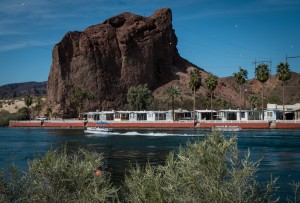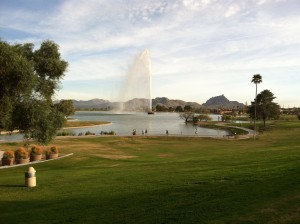PARKER STRIP – In 2005, according to the Bureau of Land Management, the 16 concessionaires leasing BLM land along this strip of the Colorado River reported more than 4 million “visitor days”, people like these motorboaters enjoying a warm (but not hot) late winter day on the river.
That’s a mobile home and RV park called Echo Lodge Resort on the far bank, the California side, that reported 609,577 of those visitor days. These pockets of land along the river have the feel of the Southern California beach communities of my youth, shacks wedged into every buildable chunk of land within striking distance of the water.
It’s early in the season – still too cool to water ski, I’m told, but that will come. This is the stretch of the Colorado that Philip Fradkin, writing with despair, described nearly four decades ago as “charnel river“:
It is the river as theater, where each of the 125,000 weekend visitors compressed into the fourteen miles, and huddled as close as possible to the cool water, can act. To be a protagonist, rather than part of the supporting cast, one needs a sleek water-ski boat in the shape of a tapered arrowhead and powered by a jumble of chrome.
As I drove the Parker Strip Saturday, I was thinking about a conversation with a member of my braintrust who complained about a central dilemma – the way we stumble forward in our water policy discussions amid “half-told stories about the value of water”.
By the time the Colorado River gets here, it has become, in Fradkin’s words, a “river no more”. At this point, downstream from Parker Dam, Los Angeles and central Arizona have already taken their cut. The water flowing past Echo Lodge is being carefully meted out largely for farmers in the river valley to the south, and in the Imperial and Coachella valleys, and Mexicali.
The precision with which water is quantified here is exquisite, with releases from Parker Dam just upstream measured to an accuracy of less than one half of one percent – 20,818 acre feet released Feb. 21, the day I drove the Parker Strip. Every drop is tagged in the riverine accounting system.
Fradkin comes from a world – it’s the entire premise of one of the best of the Colorado River books
– in which the river has value for its own sake. He deplores, without feeling a need for argument, the water-skiing-and-beer culture and the river-turned-irrigation system on which it depends.
Those 4 million visitors likely disagree.
There’s no one right answer here, no one “right” value of water. We have a diverse society, with people valuing water different ways. On this trip I’ve visited the Colorado River Indian Tribes, where some of the oldest, most senior Colorado River water rights are irrigating 58,000 acres of the most beautiful alfalfa fields you’ll ever see, lush and green and growing food for livestock that we then mostly turn into food for people. I also spent time in Phoenix, where a culture of imported water and fountains combines with a delicate water policy dance around both embracing and denying the problems posed by scarcity. I was there for meetings with folks working deeply and carefully on the scarcity side of things, but then there’s the fountain at Fountain Hills, which sends a very different message.
When I shared a picture of the fountain, one of my tweeps responded with a friendly welcome to Phoenix followed by “#recycledwater”. Which is true, but only complicates things with yet another half-told story. It’s a pretty cool fountain, but some people in Phoenix are recycling their treated sewage by putting it back into the aquifer for future use.


